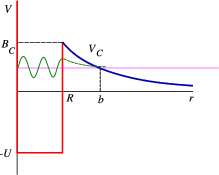5.4 Barrier penetration
In order to understand quantum mechanical tunnelling in fission it makes sense to look at the simplest fission process: the emission of a He nucleus, so called radiation. The picture is as in Fig. 5.12 .
Suppose there exists an particle inside a nucleus at an (unbound) energy . Since it isn’t bound, why doesn’t it decay immediately? This must be tunnelling. In the sketch above we have once again shown the nuclear binding potential as a square well, but we have included the Coulomb tail,
| (5.20) |
. The height of the barrier is exactly the coulomb potential at the boundary, which is the nuclear radius, , and thus . The decay probability across a barrier can be given by the simple integral expression , with
(here is the velocity associated with ). In the limit that we find
| (5.22) |
This shows how sensitive the probability is to and !


